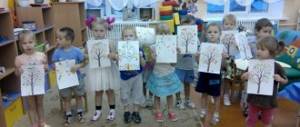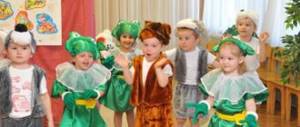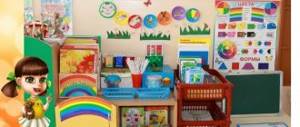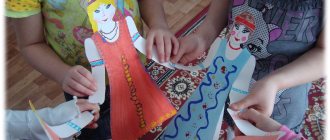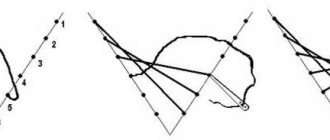What abilities are called intellectual?
The intellectual abilities of a preschooler are often identified with awareness or the ability to perform certain algorithms, while these are different concepts and different components of a child’s development. Abilities are not knowledge or skills. They can be compared to a tool that allows you to acquire knowledge, operate with it, and also learn to perform actions.
As for intellectual ones, they relate to cognitive, mental abilities, but have a narrow specialization and are a “tool” of thought processes. Intellectual abilities are the internal organization of thinking, active mental activity.
A favorable period for the development of intellectual abilities begins in preschool childhood, when the child learns to independently analyze, reason, grasp patterns, and identify cause-and-effect relationships.
In comparison with other types of abilities, the peculiarity of intellectual abilities is that they are applied not to a separate type of activity, but to all areas. The more developed intellectual abilities, the more effective the child is in many narrowly focused activities, because he is able to think independently in order to find new approaches and ways to solve emerging problems.
Stages of intelligence formation
Mental processes have a huge impact on the intellect, and thinking, in turn, is closely related to movement. While the child is small, he needs to move a lot: crawl, run, exercise, climb stairs, jump. All this contributes to brain development.
There is no need to limit the baby’s mobility; he should explore the world in motion. Inhibitions inhibit brain activity.
The baby is two years old - it’s time to pay attention to the formation of logic. For the baby, you should choose exercises to develop logical thinking.
The main thing is that classes are conducted in an accessible form. During this period, they begin to actively enrich their vocabulary and speech; they read a lot to the baby and talk to him.
The first stage of development is 2-3 years, during this period the baby’s perception of the world is based on data provided by the senses. Cognitive development in early childhood should be organized taking this factor into account. The learning process is structured as follows:
- The baby is given objects of various textures, and by feeling them, the baby will come to the conclusion that all objects have a different surface;
- the formation of thinking can be influenced by exposure to a variety of aromas and tastes;
- improvement of intellectual abilities occurs through influence on the sphere of the psyche; in this case, fairy tales are a proven assistant.
The second stage occurs in three to four years. At this age, the baby begins to feel like an individual, he has his own plans, the baby tries to do everything on his own. You should not disturb him; it is necessary to create an environment in which the child could, being active, explore the world. At the second stage, parents should pay attention to the following factors:
- encourage the baby's initiative;
- give feasible instructions;
- takes the child’s achievements seriously;
- encourage creative thinking;
- cultivate love for all living things, teach to treat nature with care.
The third stage is preschool. Cognitive development in preschool age should take place in a playful way. At this age, the child’s leading activity is play: board, computer, and outdoor games will help to acquire new knowledge and skills in an unobtrusive environment. For example, gaming intelligence training online.
Children are taught to read, write and count.
The cognitive development of a preschooler must certainly include improving speech. And also the development of curiosity.
Thus, children begin to gradually become involved in educational activities.
At this age, it is necessary to focus on communicating with people. Communication skills will help you make friends and engage in group activities. The development of the intellectual abilities of preschool children is the basis for learning at school.
Upon entering school, a first-grader begins to become acquainted with scientific knowledge; in addition, his social skills are actively developing. The student learns to establish relationships with classmates and teachers. The intellectual development of a child affects both his school performance and the development of his social skills.
In adolescence, cognitive interest begins to subside. During this period, parents need to stimulate the teenager’s mental activity and cognitive development, prepare him for the upcoming exams not only mentally, but also emotionally.
Components of intellectual abilities
What kind of magic is contained in intellectual abilities if they can increase the success of many actions? Understanding this issue will be achieved by identifying the main active components that form intellectual talent:
- ability to analyze
- ability to combine and transform
- ability to reason and draw conclusions
- ability to plan
Let us reveal the essence of the listed components, thanks to which the search activity, intelligence and mental initiative of a preschooler are manifested.
The ability to analyze lies in the ability to highlight various features and characteristics of an object.
The ability to combine elements and transform objects allows you to create different combinations of objects and their components.
The ability to reason is manifested in the ability to formulate one thought after another so that the subsequent judgment follows from the previous one or cause-and-effect relationships are identified.
The ability to plan is to think through several steps to obtain a result, to achieve a set goal.
Each of the listed components has quantitative and qualitative characteristics. The more a child's ability is developed, the more data he will be able to cope with and the fewer erroneous assumptions and actions he will make.
For example, when composing puzzles into a picture, a child will not randomly move them for the sake of an accidental hit, but will begin to pay attention to the curly edges and part of the picture. By the way, this feature can be used as a primary diagnosis of the development of a preschooler’s intellectual abilities.
How do intellectual abilities manifest themselves in preschool age?
The first manifestations of a child’s intellectual abilities occur through visual modeling.
Visual models reflect the properties and relationships of objects and phenomena, therefore they are a means of understanding real relationships.
Look at the drawing of a 5 year old child. Everything he depicts is far from a copy. The child models by drawing a superficial similarity of objects, people, and living nature. It's difficult to draw a Christmas tree, but it's easy to draw a green triangle. It is very difficult to draw a person - a circle and a few dashes or a circle paired with a triangle will help out.
Visual modeling of a preschooler is improved and complicated based on the development of intellectual abilities. Starting with simple replacements of real objects with simple forms, children by older preschool age learn to build models themselves using symbolic notations.
Potential of younger preschoolers
Children of primary preschool age correlate real objects with geometric shapes, but focus on the shape of the object, without taking into account the size. They are just beginning to develop the ability to analyze, allowing them to notice one or two properties of a real object.
If you place a lot of rings of different colors in front of your baby and ask him to assemble a single-color pyramid, he will string rings of the same color onto the rod, not paying attention to their sizes. When an adult directs the child’s attention to a quantity, he begins to take this property into account.
Younger preschoolers build vertical towers and horizontal models (train, bridge). They are able to combine several objects into a group. The child copes with the task if he is offered several cards with images of food, clothing, transport, furniture, etc., and asked to choose pictures “what is in the room”, “what can be eaten”.
Also, children 3-5 years old take their first steps in planning. They complete the task after listening to the approximate instructions: “Place the bear and the bunny next to each other, and the doll in front of them. Hide the ball under the table and the pencil in the box.” Such tasks stimulate the development of the child’s intellectual abilities, and also develop memory and attention.
Intellectual abilities of older preschoolers
Visual modeling in older preschool age rises to a higher level. From using models of specific objects, children move on to generalized symbols that reflect the essential features of objects.
Constructive activity develops - a vivid example of visual modeling that contributes to the formation of intellectual and creative abilities. If an older preschooler builds a spatial model, then it is an entire empire with castles, gates, and bridges.
Older preschoolers learn to draw up graphic models (room plan, playground diagram) and assemble structures based on the drawing. They are interested in finding ways in all sorts of labyrinths.
The development of intellectual abilities is carried out through understanding cause-and-effect relationships, learning to combine disparate elements into a coherent scheme.
Six-year-old children are more successful in finding essential features and classifying objects using generalized concepts (identifying groups of animals, fruits and vegetables, transport, dishes), inventing original characters, endowing them with properties borrowed from other characters.
Planning a chain of steps moves into an internal plan. The older preschooler prefers to communicate what result he is determined to achieve rather than list the steps: “Now I’ll build a city,” “I’m drawing a flying saucer - then I’ll tell you how it works.”
In older preschool age, many children willingly operate with mathematical symbols - numbers, images of geometric shapes. This has a beneficial effect on the development of specialized mathematical abilities, which are also intellectual.
Work program of a circle for the intellectual development of children in the preparatory group for school
Goal: development of pre-engineering thinking and cognitive abilities of preschool children, formation of logical-mathematical thinking of children of senior preschool age through non-standard didactic materials (“Dienes Logic Blocks”).
1. Explanatory note The additional educational program “Magic Blocks of Dienesh” provides additional education for children of the preparatory group on the development of pre-engineering thinking through non-traditional didactic material. The additional educational program of the MBDOU “Kindergarten No. 21 “Cheburashka” of a general developmental type with priority implementation of activities on the cognitive and speech development of children” was developed in accordance with regulatory documents: Federal Law of December 29, 2012 No. 273 - Federal Law “On Education in the Russian Federation” Federation". SanPiN 2.4.1.3049-13 “Sanitary and epidemiological requirements for the design, content and organization of work in preschool organizations.” Letter from the Ministry of Education of the Russian Federation dated June 18, 2003. No. 28-02-484/16 “Requirements for the content and design of educational programs for additional education of children.” Letter of the Ministry of Education and Science of Russia dated December 11, 2006 No. 06-1844 “On approximate requirements for additional education programs for children.” Charter of MBDOU “Kindergarten No. 21 “Cheburashka”.
The main goal is that the program is aimed at children successfully mastering the basics of mathematics, computer science, and design skills:
- Allows you to vary the use of games and exercises at different stages of learning;
- Helps create new conditions for nurturing the child’s intellectual abilities.
Goal: development of pre-engineering thinking and cognitive abilities of preschool children, formation of logical-mathematical thinking of children of senior preschool age through non-standard didactic materials (“Dienes Logic Blocks”).
Tasks:
- Develop logical thinking in children.
- Form ideas about mathematical concepts.
- Develop the knowledge, skills and abilities necessary to independently solve educational and practical problems.
- Foster independence, initiative, perseverance in achieving goals, and overcoming difficulties.
- Form cognitive processes, mental operations (analysis, comparison, synthesis);
- To develop basic skills in an algorithmic culture of thinking.
- Develop imagination, fantasy, modeling and design abilities, creative and technical abilities.
In the draft Federal component of the state educational standard of general education, one of the goals related to the modernization of the content of general education is the humanistic orientation of education. It determines a person-oriented model of interaction, the development of the child’s personality and his creative potential. The process of profound changes taking place in modern education puts forward as a priority the problem of developing creativity and thinking that contributes to the formation of a well-rounded personality. A child by nature is a researcher, an experimenter, discovering the world with joy and surprise. There are many ways to present children with the opportunity to independently discover the reason for what is happening, get to the bottom of the truth, understand the principle and logic of solving a given problem and act in accordance with the proposed situation. Mathematics enters a child’s life from the moment of birth. The child grows and hears a lot of new things every day. If from early childhood you give your child the opportunity to get acquainted with mathematics, make friends with it, see it as an interesting game in which you want to learn something new and unusual, then at school positive emotions, a sense of mastery of the subject, and interest in it will be associated with mathematics. Any mathematical task involving ingenuity, no matter what age it is intended for, carries with it a certain mental task, which is most often disguised by an entertaining plot.
The entertaining nature of this didactic material masks the mathematics that many consider dry, uninteresting and far from the lives of children. Thanks to games with Dienesh blocks, children develop all mental processes, mental operations (the ability to compare, analyze, systematize, classify, generalize, draw conclusions, inferences); modeling and design abilities, which in turn contributes to the development of certain brain centers that influence the development of speech. Also, these intellectual games contribute to the development of creative abilities: fantasy, imagination, visual and effective thinking, spatial orientation, attention.
1.1. Pedagogical feasibility of the program.
- Aimed at children successfully mastering the basics of mathematics and computer science in the future.
- Allows you to vary the use of games and exercises at different stages of learning.
- Helps create new conditions for nurturing the child’s intellectual abilities.
1.2.Targets and objectives of the program.
- Develops logical thinking. Develops the concept of set, operations on sets (comparison, partitioning, classification, abstraction). Forms ideas about mathematical concepts (algorithm, coding, decoding of information, coding with a negative sign).
- Develops the ability to identify properties in objects, name them, adequately indicate their absence, generalize objects by their properties (one, two, three at a time), explain the similarities and differences of objects, justify one’s reasoning
- Develops spatial concepts.
- Develops the knowledge, skills and abilities necessary to independently solve educational and practical problems.
- Develops independence, initiative, perseverance in achieving goals and overcoming difficulties.
- Develops cognitive processes and mental operations.
- Develops creativity, imagination, fantasy, modeling and design abilities.
- Develops mental functions associated with speech activity.
1.3. Distinctive features of the program Preschool age is a period of active development of cognitive activity. At this time, the formation of the first forms of abstraction, generalization and simple inferences takes place, the transition from practical to logical thinking, the development of arbitrariness of perception, attention, memory, and imagination. Therefore, one of the pressing problems of preschool pedagogy is the effective development of the intellectual and creative abilities of preschoolers. The use of educational games in the pedagogical process allows you to rebuild educational activities: move from the usual activities with children to cognitive play activities, organized by adults or independently. They are important and interesting for children, varied in content, very dynamic and include children’s favorite manipulations with gaming material, which can satisfy the child in motor activity, movement, helps children use counting, and controls the correct execution of actions. The principles underlying these games - interest - knowledge - creativity - become as effective as possible. During games, an intellectually passive child is able to complete a volume of educational work that is completely inaccessible to him in a regular lesson.
Game exercises and games are entertaining and correspond to the level of complexity of tasks provided for in modern variable programs. To implement an individual approach, it is advisable to organize work taking into account three levels of development (prerequisites) of children’s logical thinking:
- Formed.
- At the stage of formation.
- Not formed.
1.4.Principles of program construction:
- The principle of entertainment is used to involve children in purposeful activities, forming in them a desire to fulfill the requirements and the desire to achieve the final result.
- The principle of novelty allows you to rely on involuntary attention, arousing interest in work, by setting a consistent system of tasks, activating the cognitive sphere.
- The principle of dynamism is about setting goals for the child’s learning and development, which are constantly deepening and expanding in order to increase children’s interest and attention to learning.
- The principle of cooperation - allows you to create, in the course of productive activities, a friendly attitude towards each other and mutual assistance.
- Systematicity and consistency - assumes that knowledge and skills are inextricably linked and form an integral system, that is, educational material is acquired as a result of constant exercises and training.
- Taking into account age and individual characteristics is based on knowledge of the anatomical, physiological and mental, age and individual characteristics of the child.
- Scientificity - consists in the formation of a system of scientific knowledge in children, in the analysis and synthesis of objects, highlighting important, essential features in it (color, shape, size), in identifying possible interdisciplinary connections, in the use of accepted scientific terms (for example, square, rectangle, triangle, circle, etc.)
1.5.Principles of interaction with children: The program allows you to individualize complex game tasks: stronger children can find more difficult options, less prepared ones can find easier work. At the same time, the educational and developmental meaning of the game is preserved. This makes it possible to warn the child against fear of difficulties, to teach him to create and create without fear.
In the process of working according to the circle program, children learn colors and their shades; names and distinctive features of geometric figures (in poetic form), enrich vocabulary, learn to work according to diagrams, compare and generalize objects according to a certain characteristic (color, length, shape, etc.)
1.6.The program implementation period is 1 year:
- 1 time per week
- Time: 30-35 minutes
- Per month – 4 lessons
- Number of children – 18, age 6-7 years.
2. Program effectiveness: Expected results are aimed at:
- the formation in pupils of primary ideas about the basic properties and relationships of objects in the surrounding world: shape, color, size, quantity, number, part and whole, space and time.
- Development of children's cognitive interests, expansion of experience of orientation in the environment, sensory development, development of curiosity and cognitive motivation, formation of cognitive actions, formation of consciousness.
- Development of imagination and creative activity.
- Development of perception, attention, memory, observation, ability to analyze, compare, highlight characteristic, essential features of objects and phenomena.
- Development of the ability to establish the simplest connections between objects and phenomena, to make the simplest generalizations.
As a result of play activities, children will learn:
- Compare objects by length, height, thickness, color, shape.
- Follow verbal instructions and work according to diagrams.
- Encode and decode information.
- Use code cards and a code indicating the negative sign “not” (not a square, which means a circle or triangle, etc.)
- Improve your communication skills.
2.1. Methodological support of the program:
- Classes in this program consist of practical activities for children.
- Conducted under the guidance of a teacher.
2.2 Program monitoring.
The purpose of monitoring is to track the results of the program.
To assess the effectiveness of work, I chose the methods of Z.A. Mikhailova, T.D. Richterman:
1. “Diagnostics of the development of elements of logical and figurative thinking, the ability to analyze and synthesize, as well as the characteristics of attention and perception of color, shape and size.”
2. “Diagnostics of the development of elements of logical thinking “Free classification”.
For the full text of the material, the work program of the circle for the intellectual development of children in the preparatory group for school, see the downloadable file
. The page contains a fragment.
| Author: Dvoryankova Tatyana Viktorovna → Tanya9818 08/05/2018 0 3475 400 | Comment |
Thank you for your mark. If you want your name to be known to the author, log in to the site as a user and click Thank you again. Your name will appear on this page.
Login | Registration
Have an opinion? Leave a comment
Techniques and means for developing intellectual abilities
The cognitive and intellectual activity of a preschooler, based on analysis, synthesis, transformation, establishing cause-and-effect relationships and planning, creates conditions for the development of intellectual abilities.
Parents should not rely on their children's intellectual abilities to develop on their own. Moreover, such expectations should not be associated with computer toys, which teach children to quickly respond to certain combinations and, with rare exceptions, have nothing to do with mental activity.
There are proven methods and techniques that contribute to the formation of intellectual flexibility and related abilities:
- Problem solving
- Search and research activities
- Visual modeling
- Encoding and Decoding
- Coming up with a plot based on an episode or given roles
- Generating ideas using the brainstorming principle
- Games for the development of verbal and logical thinking
Of course, parents will have to work a little to select cards for classifying images or encoding a message into a rebus, coming up with a problem problem or an idea for brainstorming. But the successful development of a preschool child occurs only with the active participation of an adult. Even the selection of educational toys requires a responsible attitude.
Intellectual development of a preschooler
Children are inquisitive explorers of the world around them. This feature is inherent in them from birth. The formation of cognitive interest in preschoolers is one of the most important tasks of teaching a child in kindergarten. Cognitive interest is the leading motive of educational activity, directing a person to master knowledge and ways of knowing. As studies have shown (A.P. Arkhipova, N.A. Belyaeva, L.I. Bozhovich, etc.), genuine cognitive interest is the basis of educational activity, since:
• interest contributes to the formation of deep and lasting knowledge;
• develops and improves the quality of mental activity, activity in learning, favors the formation of abilities;
• creates a more favorable emotional background for the flow of all mental processes.
The most important means of intellectual development of a preschool child is the study of mathematics in kindergarten. A constant increase in children's interest motivates play activities, activity in self-expression, searching and finding an answer, guessing, revealing the secret of the game and creates a positive emotional mood that promotes intellectual activity and increases its effectiveness.
According to the Federal State Educational Standard for Preschool Education (FSES DO), “Cognitive development involves the development of children’s interests, curiosity and cognitive motivation; formation of cognitive actions, formation of consciousness; development of imagination and creative activity" [6].
The foundation of an active, proactive, creative personality is laid in preschool childhood. It is during this period that important prerequisites are created for the development of children’s cognitive interests.
At the present stage of development of information technologies, ICT (information and communication technologies) tools are increasingly being introduced into the educational process. At the stage of preschool education, interactive games can become an assistant in organizing cognitive development.
Since play is the leading activity of preschoolers, it has ample opportunities for the comprehensive development of children.
An interactive game is a method of teaching and upbringing that combines the functions of education, development and upbringing of children. One of the leading areas of application of interactive games is the research and cognitive activity of the child. The child receives information through cognitive processes: perception, thinking, imagination, sensation, attention, speech, memory. The development of cognitive processes is based on analyzers; thanks to them, the child learns more effectively and fully about the world around him [1].
The introduction of innovative technologies is intended, first of all, to improve the quality of education, increase children's motivation to acquire new knowledge, and speed up the process of acquiring knowledge. In turn, the author of the “Cognitive Development of Children” methodology, Tatyana Ivanovna Grizik (according to the educational program of our kindergarten) recommends the use of “manuals for the cognitive development of preschoolers, which can be broadcast both using multimedia installations and laptops, and using computers, interactive tables... »
An interactive poster is a means of providing information that can actively and variedly respond to user actions.
Its main goal is not just to place some data on it, but to increase the visibility of information and the effectiveness of the learning process.
The main advantage of interactive games is visibility - a tool for mastering new concepts, properties, and phenomena. In addition to clarity, children also perceive new information by ear, with the help of the movement of objects. In addition, by practicing interactive games on their own, the child can control the pace and number of tasks performed, which meets the principle of individualization, in accordance with the Federal State Educational Standard for Educational Education.
Using interactive and multimedia tools, it is possible to simulate various situations from the environment, create visual riddles on various topics, introduce children to the seasons, professions, animal homes, vegetables and fruits, etc. [5].
Work with interactive technologies can be organized in different forms:
- the individual form presupposes the child’s independent solution of the tasks assigned to him;
- to solve problems in pairs, the pair form is used;
- when using a group form, children are divided into subgroups;
- if the task is performed by all participants at the same time, this form is called collective or frontal.
There is also a planetary form - the most complex form of interactive learning. In planetary form, children break into subgroups, work on projects, and then voice their research [4]. To conduct interactive games, the authors N.L. Kryazheva, K. Foppel, E.K. Lyutova, G.B. Monina proposed a certain algorithm:
1) Selection of interactive games by a teacher for a group of children. Preliminary work is possible;
2) Introducing children to the purpose of the game, rules and instructions. Information must be formulated in an accessible and clear manner;
3) Children’s interaction with each other during the game. In difficult moments, the teacher corrects the actions of preschoolers;
4) Summing up the game. After the end of the interactive game, an analysis of the results is carried out, which includes reflection on the emotional and content aspects [2].
There are several types of interactive games for preschoolers:
- Educational games: aimed at developing cognitive abilities, emotional and moral development, and developing imagination. They do not have a clearly defined didactic task - they are tools for creativity and self-expression of the child. This type includes a variety of graphic editors (“coloring books” and “drawing books”), music editors, fairy tale constructors, work with illustrations, etc.
- Educational games: the child is invited to solve one or another didactic problem in a playful way. This includes games for developing children’s initial mathematical understanding, teaching native and foreign languages, aesthetic and moral education, speech development, etc.
- Logic games: aimed at developing the logical thinking of a preschool child. These games include puzzles with one or more problems that the child must solve.
- Fun games: give the child the opportunity to spend time usefully in an entertaining way. Here he can go on an exciting journey with his favorite fairy tale hero or come up with a further development of the cartoon plot [3].
Interactive games combined with high pedagogical skills make the educational process of preschool education diverse, lively and unobtrusive for children. Using interactive games, children’s motivation to learn increases (which is especially important in the pre-school group), children learn new forms of cooperation, the child’s reflection and assessment of their achievements are formed.
I have developed an interactive math poster called “Find the Shape” for older preschool children.
The objectives of this game were to:
- Teach children to identify special features of figures using visual and tactile-motor analyzers.
- Learn to distinguish shapes based on several characteristics: shape, color; compare a group of objects by the number of figures.
Tasks:
- Develop an understanding of flat geometric shapes in children (circle, square, triangle, rectangle).
- Strengthen the ability to navigate in space.
- Improve counting skills.
- Give children joy and pleasure from games and exercises with mathematical content.
- To cultivate a desire to overcome difficulties, self-confidence, and interest in mathematics.
Fig 1. Insert the missing figure
Fig 2. Insert the missing square
The use of interactive games along with traditional teaching methods increases the effectiveness of education and upbringing of children, enhances the level of understanding of information, and develops the creative abilities of children. The educational process in a preschool educational institution can be more successful and effective if a computer and interactive technologies are used as a didactic tool. But the use of ICT must comply with the requirements of SanPin.
Links to sources:
1. Vinogradova, N. A. Educational projects in kindergarten [Text]: A manual for educators / N. A. Vinogradova, E. A. Pankova. M.: Iris-press, 2008—208 p.
2. Kiseleva L.S. Project method in the activities of a preschool institution [Text]: Proc. - method. allowance / Kiseleva L.S. 2010 —242 p.
3. Gorvits Yu.M. New information technologies in preschool education [Text]: Textbook. - method. allowance / Gorvits Yu.M. M, 1998—12 p.
4. Komarova T.S. Information and communication technologies in preschool education [Text]: Textbook. - method. allowance / Komarova T.S. M, 2011—44 p.
5. Novoselova S. L. Computer world of a preschooler [Text]: textbook. for universities / Novoselova S. L. M.: New School, 1997—p.39-41
6. Federal State Educational Standard for Preschool Education [Text]: Federal State Educational Standard for Preschool Education—2013.Introduced 2013—17—10—M.: Prosveshchenie Publishing House, 2013.

